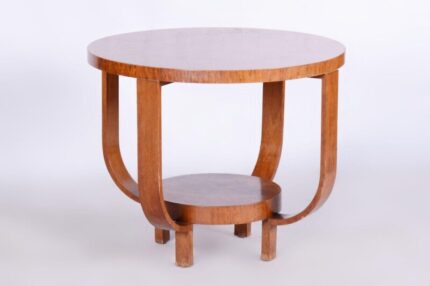Exceptional and valuable small Italian Biedermeier style sideboard in Sapele wood with birch inlays; the massive upper top is rectangular and follows the profile of the cabinet; below it, we find a convenient drawer with handle; the large, functional space underneath is divided by a shelf and closed by a door with a handle; the practical gilt brass handles are retractable ring handles; the base is slightly shaped; overall, an essential and linear structure, but the cabinet has a unique and extraordinary charm because of the fine inlays that decorate it. On the front of the drawer are depicted with the inlay (or marquetry) technique soft and elegant garlands held together by graceful fabric ribbons; on the door, there is a lightly carved frame within which there is a decoration again with the garland theme, but much richer and more elaborate, skillfully balanced and well distributed; the uprights on either side of the door also have fine hollow rectangular carved frames that contribute to lightening the aesthetics making the cabinet even more refined. A skilled master craftsman cabinetmaker executed this artifact in the Biedermeier style in a perfect and meticulous manner between 1885 and 1890 in the area of Lendinara, in the province of Rovigo (Italy) one of the most prestigious furniture-making districts of the Veneto; the artist succeeded in creating the delicate and refined birch inlays on the sapele base of the cabinet creating an exceptional and exclusive color contrast and giving life to a true work of art. The Biedermeier style that emerged after the Congress of Vienna and the decline of the Napoleonic empire was aimed particularly at the bourgeoisie eager for simple and functional furniture. The aim of the Biedermeier art movement is to enhance sobriety and harmony, modifying some of the stylistic motifs from the previous period, but stripping them of all the ornamentation, frills, and excesses that had characterized it. The technique of inlay (or marquetry) has a very ancient history from Egypt to Asia Minor; it was from here that it spread arriving in today’s Europe and Italy. It was during the period from the 14th to the 16th century that Inlay knew its heyday, and until 1550 it remained an exclusively Italian art form. Among the many workshops in northern Italy, that of the Canozi family from Lendinara (Rovigo, Italy), known as “I Lendinara,” to whom some associate the origins of the Carthusian Tarsia technique, had considerable prestige. Inlaying (or tarsia) using the Carthusian method is done by grafting into a solid wood base decorative elements of different woods, designed, cut first, and shaped to match perfectly with the recess made previously on the base in which they will be housed. Its right size, symmetry, the balance of proportions, and its precious inlays, make our piece of furniture a valuable and versatile piece of furniture that can be placed without difficulty in any type of environment. The object has been hand restored by our team of craftsmen and is in perfect condition. Measures width cm.71, depth cm.50, height cm.82.
- Dimensions
- 27.95ʺW × 19.69ʺD × 32.28ʺH
- Period
- Late 19th Century
- Country of Origin
- Italy
- Item Type
- Vintage, Antique or Pre-owned
- Materials
- Sapele
- Condition
- Good Condition, Restored, Some Imperfections
- Color
- Brown
- Condition Notes
Completely Restored
Completely Restored less











































Reviews
There are no reviews yet.